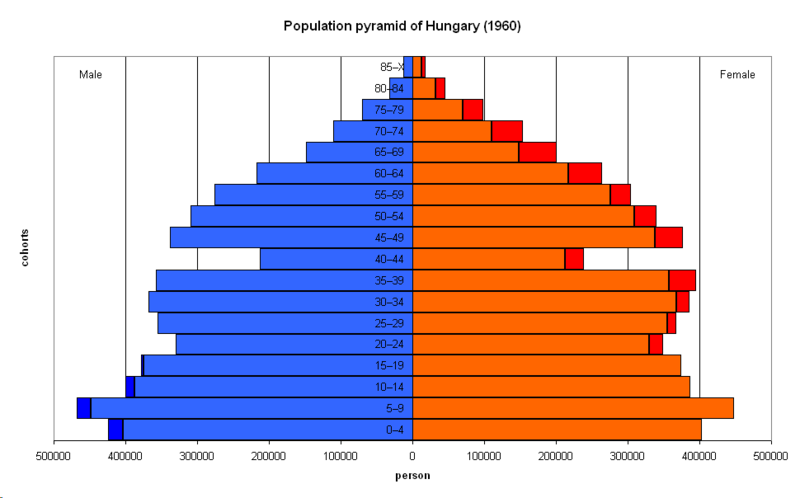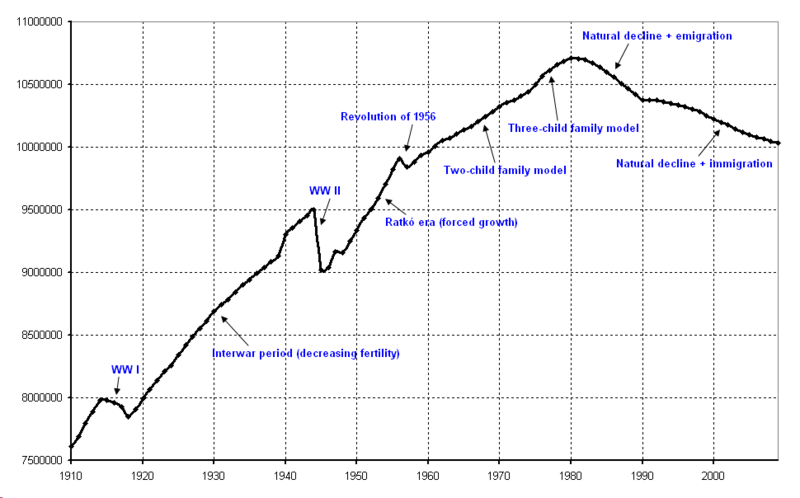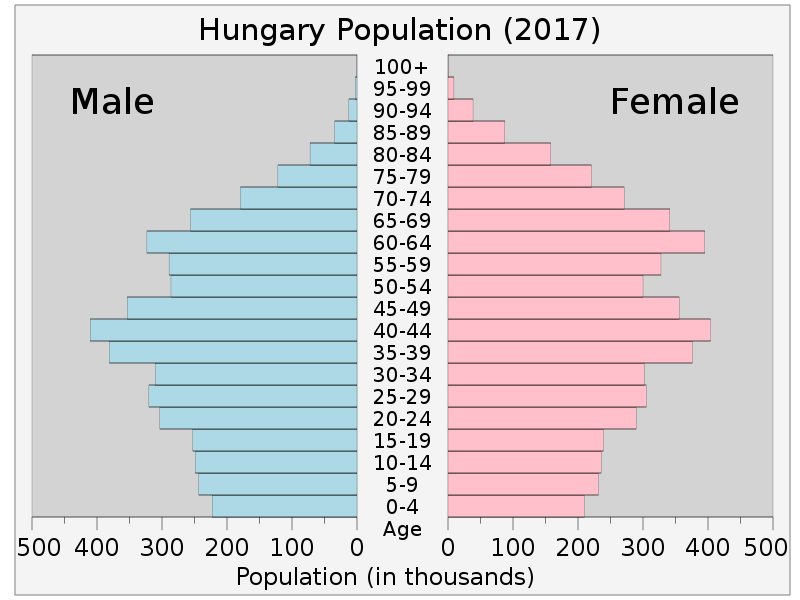Despite all the upheavals and uncertainties the twentieth century unleashed upon Hungary, the country's population increased for the bulk of those tempestuous one hundred years.
Though Hungary’s population continued to grow for much of the twentieth century in spite of many disasters and instabilities plaguing the century, the country’s fertility rate over the course of those ten decades reveals a significant downtrend. Hungary’s fertility rate was a remarkable 5.28 in 1900, but this dropped by roughly 1.0 per decade until 1930 when the rate settled at 2.84. Between 1930 and 1946 – a period that included the Great Depression and the Second World War – Hungary’s fertility bounced between 2.5 and 2.8. Although these numbers are half of what they were at the beginning of the century, they are still above the minimum 2.1 figure required to ensure population replacement, which in turn helps explain why Hungary’s population continued to grow despite the falling fertility rate and the sizable casualties the Second World War had inflicted upon the country. The fertility rate managed to remain above sub-replacement even in 1946-47, which marked the worst case of hyperinflation in recorded history,
Much of the decline Hungary's fertility rate between 1900 and 1946 can be attributed to conventional factors such as urbanization and the changing role of women in society, but the slow and steady weakening of the traditional Christian family and social framework that had dominated Hungarian society since its inception certainly played a role as well. Although fertility rates dropped rather drastically in the first half of the twentieth century, Hungarians maintained some semblance societal health by upholding a fertility rate that exceeded replacement levels.
The waning of Christian social norms in the first half of the century were ground into the dirt when the communists seized control of Hungary in 1946. The communists officially suppressed and controlled religion within Hungary. They openly mocked any mention of the metaphysical, made a hobby of rounding up and imprisoning the clergy, and worked tirelessly to establish a purely materialistic dictatorship of the proletariat within the country’s borders. The first decade of communist rule was particularly violent and oppressive, which caused the fertility rate to continue its decline. However, it remained above replacement levels despite all the turmoil and uncertainty the communists induced within the country. For example in 1956, the year marking the failed Hungarian uprising against the communist regime, the fertility rate in Hungary was still slightly above replacement levels at 2.44 .
Although the revolt against the communists ultimately failed, it did succeed in loosening communism's iron grip somewhat. True, Hungarians remained oppressed, but they were not as oppressed as they had been before 1956. Nevertheless, Moscow’s attempts to provide the nation with a kinder, gentler version of communism – one emphasizing increased material comfort, social stability, and slight increases in personal freedoms – did nothing to improve the fertility rate, which sank to below replacement levels for first time in Hungary’s recorded history.
I surmise the unprecedented 2.02 sub-fertility rate recorded in 1960 had much to do with the despair communism induced in the general population. Though the country maintained acceptable standards of living from a historical perspective, Marx’s promise of utopia showed little signs of materializing. Communism may have provided enough to live on, but it provided little to live for. Unsurprisingly, alcoholism and suicide rates rose as the fertility rate continued to fall. By the early 1970s, Hungary’s fertility rate had cracked below 2.0, prompting the communists to begin pushing a three child policy to increase fertility among the population. Amazingly, the social schemes the communists promulgated had an immediate and positive effect on the fertility rate, which quickly jumped above sub-replacement levels again and remained above sub-replacement levels for the better part of four years. However, the boost the communist family schemes provided proved to be the equivalent of a sugar high – they gave a quick burst of energy, but lacked the nourishment required to make the social engineering sustainable. By 1978, the fertility rate was back below replacement levels again at 2.08, despite the communist's desperate efforts to counteract it, remained below replacement levels for the remainder of their time in power.
Hungary’s population peaked in 1980, which was around the same time communism peaked. Though it would take another nine years to officially collapse, communism in Hungary grew observably weak and fatigued in the 1980s; yet this political devitalization did little to revitalize the country’s fertility rate. On the contrary, the more liberal and laissez-faire the communists became, the more the fertility rate fell. After 1980, the rate dropped to below 2.0. By the time the Iron Curtain came down, Hungary’s fertility rate was a pathetic 1.78.
When the Iron Curtain was dismantled, Hungary became part of the liberal West. After nearly fifty years of political oppression and despair, the country hungered for the personal freedoms and material prosperity Western liberalism offered. It certainly was an optimistic time, and one would assume rejoining the West would have an overall positive effect on the country’s fertility rate, and for a few short years it did. Coinciding with the hope inspired by rejoining the West, Hungary’s fertility rate climbed slightly in the early 1990’s, but by 1999 it nosedived all the way down to 1.29 and remained at those abysmal levels all the way to 2011 when it sank to 1.23, which is the lowest recorded fertility level in Hungarian history.
If nothing else, fertility rate statistics reveal Hungary’s response to communism had been despairing and suicidal. Nevertheless, these stats also show Hungary’s response to Western liberalism after the fall of the Iron Curtain has been even more despairing and suicidal. Though sub-fertility stains both periods, the numbers show Hungarians chose to have more children under communist oppression than they do in the apparent freedom of Western liberalism. As pernicious as communism was, it appears to have been less despair-inducing and suicidal than Western liberalism has been in Hungary - at least as far as fertility rates and societal health are concerned.
Of course, communism and liberalism are both forms of Leftism. Taken together, it is quite apparent that both are detrimental to a country’s fertility rate and overall demographics, which is hardly surprising considering the basic tenets of Leftism. All the same, it is rather startling to discover that liberalism, which is touted for its apparent love of freedom, tolerance, and human rights, is far more despair-inducing and suicidal in demographic terms than communism ever was. As unbelievable as it seems, Hungary's immersion into Western liberalism only exacerbated the demographic malaise communism had initiated in the second half of the twentieth century.
Surprisingly, Hungary’s fertility rate has experienced a slow but steady increase this decade. The fertility rate has risen nearly every year since the 1.23 trough set in 2011 and now sits at 1.49. Though the figure is still paltry, this minor turnaround could be attributed to Viktor Orbán and his push to make Hungary an “illiberal democracy.” Recognizing the suicidal path the country had been on, Orbán's government has launched a massive campaign to increase the fertility rate to above replacement levels. The actions the government has taken appear to be having positive effects. Marriage rates are rising and fertility levels remain stable. Nonetheless, it is too soon to know if Orbán’s well-intentioned schemes will bear fruit. After all, the communists initiated similar policies in the 1970s, but the positive outcomes their policies produced were incredibly short-lived. When all is said and done, I fear Orbán’s policies might suffer a similar fate unless the real root of the demographic problem is dealt with.
The communists saw sub-replacement fertility as a material problem. As such, the remedies they offered were also of a material nature. Unsurprisingly, these material solutions did nothing to address the underlying immaterial cause of the problem, which was spiritual in nature. Orbán also recognizes the material dangers of sub-fertility. Like the communists in the 1970s, he is attempting to counteract the low fertility rate by offering material solutions. However, unlike the communists, Orbán seems to understand the root of the problem is spiritual in nature, which helps explain why he often praises Christianity and lauds the necessity of Christian values. Orbán may understand the root of the sub-fertility catastrophe is spiritual in nature, but the million dollar question is this - Do contemporary Hungarians understand this as well? If they do, Orbán’s admirable attempts at reversing the decline in fertility stand a chance. If not, Orbán’s family support schemes will inevitably meet the same fate the communist schemes of the 1970s did.
If history is any guide, material provisions alone will not aid the fertility rate and may actually cause more harm than good in the long term. The only solution to sub-replacement fertility - in Hungary or any other Western country for that matter - is spiritual reawakening. Anything less will only serve to accelerate or prolong the despair-induced demographic suicide plaguing Hungary and the West.
The two population pyramids below illustrate the gravity of the problem in contemporary Hungary and highlight Western liberalism's exacerbation of the demographic dilemma the communists had inadvertently initiated in the mid-twentieth century. As bad as communism was for Hungary's demography and fertility, Western liberalism has been undeniably worse.




 RSS Feed
RSS Feed

